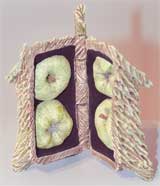Clay minis show big style

“Sliced Apples” by Suzanne Kane of New Mexico is one of 182 places in the 2004 International Orton Cone Box Show.
A hairbrush, winter gloves, a can of soup: all things one can fit in a six-inch by three-inch by three-inch box. Other good things come in small packages too, at least during Spiva Center for the Arts’ newest exhibit “Small Shapes, Big Impressions.”
The exhibit is the 2004 version of the International Orton Cone Box Competition started by William Bracker, an art instructor at Purdue University, in the early ’70s as a way to encourage and promote creativity and excellence in ceramic arts. The standard Orton cone box was chosen as the size limitation for entries. The boxes originally contained cones used to measure the temperature inside of a kiln during the firing process. The only other requirement is that the pieces must be at least 50 percent clay based.
“I think it’s lovely and curious,” said Barbara Garrett, a volunteer docent. “I didn’t even know what a cone box was.”
The competition has become a worldwide event including pieces from 28 countries, Puerto Rico and all 50 states. In the last four shows a total of 1,812 artists have submitted 2,950 ceramic art pieces for consideration. Entries are chosen for craftsmanship, creativity, imagination and aesthetic excellence in combination with the artists’ understanding of the clay. The exhibit travels nationally and internationally for two years after being judged. The current exhibit’s next stop is Anchorage.
“It’s amazing someone looked at it and thought of using it for the size,” Garrett said. “Who thinks up these things?”
The result of this unusual competition is 182 small ceramic pieces of art scattered around the center’s main gallery on boxes, tables and stands. The eccentricity of the shape seems to have brought out the eccentricities in the artists and many of the pieces are abstract representations of everyday objects and otherworldly scenes that speak volumes in such a compact space. The 2004 competition jurors, Janet Mansfield and Phil Rogers, wrote they think the size restrictions require more thought from the artists.
“This is a special show,” they wrote. “The concepts are unique. A piece must stand up for its own on that small scale and not just be a miniature. We look for skill and imagination and how a person has a real understanding of the clay. We really enjoyed the process and are very pleased with the 2004 Cone Box Show.”
These abstractly transformed objects include a host of teapots and cups with unfamiliar textures and shapes like cloud covered teacups with wings sitting on a piece of bark or the cobalt-colored “Posturing Teapot” and “Ovoid Jar,” resembling a robin’s egg. Some of the pieces are humanoid in form like “Nurture” and “Nourish,” a pair of individually cupped hands imprinted with the words “hope” and “love” delicately holding small figures curled in the fetal position.
The piece “Symbol/Substance” is a skeletal hand and arm, intricate and realistic with fingernails included, that looks like it should be clutching something like a sword.
“Merdines & Crackers” consists of an empty seemingly tin can, lid peeled back and three small mermaids atop a bed of saltine crackers.
The exhibit lends itself to deep thought and poses the question of what the artist was trying to communicate with pieces like “Strength,” which consists solely of four small, ornate hinged boxes.
Garrett said she thinks this is the true strength of the exhibit and everyone should participate in the subjectivity and creativity of the various artists’ works.
“Anybody should come to any exhibit whether it’s here or at the college or wherever,” she said. “You learn so much just by going. You expand your little minds.”
Your donation will support the student journalists of Missouri Southern State University. Your contribution will allow us to purchase equipment and cover our annual website hosting costs.



























